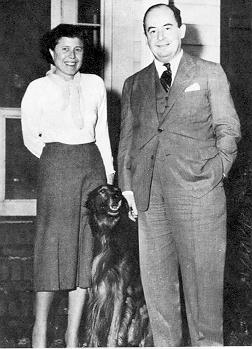 |

With Second Wife Klara and Dog Inverse |
John Louis von Neumann
 |

With Second Wife Klara and Dog Inverse |
1903-1957
John Luis von Neumann was born December 1903, in Budapest, Hungary. His father Max Neumann was a banker in Budapest, who purchased a title. While Max did not adopt the German spelling von Neumann, John did. John's mother was Margaret Kann. John was a child prodigy who could divide eight-digit numbers in his head when he was six. In 1921 his father sent von Neumann the University of Berlin to study chemical engineering and then to Technische Hochschule in Zurich two years later. John's course of study was dictated more by his father's practicality than John's interests. John coauthored his first mathematics paper which was published in 1922 with his then tutor, an assistant professor at the University of Budapest named Fekete. The next year he would publish the now standard definition of ordinal numbers. Von Neumann had also been accepted into the University of Budapest, though he did not attend classes there he scored well on the University of Budapest's mathematics examinations. 1926 saw Von Neumann receive both his degree in chemical engineering from the Technische Hochschule and his Ph.D. in mathematics from the University of Budapest for a dissertation on set theory.
Von Neumann lectured at Berlin from 1926 to 1929 and at Hamburg from 1929 to 1930, finding time to do postdoctoral work with Hilbert at the University of Göttingen. After marrying his fiancée Marietta Kovesi, von Neumann taught at Princeton from 1930 to 1933. He was apparently not a gifted teacher, largely because he was too smart and not cognizant enough of student needs. Princeton founded the Institute for Advanced Study in 1933 and von Neumann joined James Alexander, Albert Einstein, Harold M Morse, Oswald Veblen, and Hermann Weyl as initial members. In 1936 his marriage with Marietta broke up and she returned to Europe. Marietta and John divorced the following year and John married Klara a year after the divorce.
During the war von Neumann became a citizen so as to contribute to the war effort. At Los Alamos von Neumann both mathematical and introducing the implosion method for inducing nuclear fuel to explode. He would continue to work on various national defense project including the development of the hydrogen bomb. His work and travels exposed him to Turing's work, ENIAC, Howard Aiken's Harvard Mark I, (ASCC) calculator, the electromechanical relay computers of George Stibitz, and Jan Schilt's work at Columbia University's computing lab. There is little doubt that he had a formidable insight into computing, however, what he later corrected and explained as a typo was the cause of some controversy regarding the development of the stored-program general computer, which is sometimes called a von Neumann machine. In 1944 von Neumann joined the Moore School team as a consultant in the development of designs for ENIAC's successor. Von Neumann compiled the groups ideas in a report. In 1945 von Neumann began circulating the report. Early versions of the report did not list Mauchly and Eckert as authors. Though von Neumann corrected the omission, it was his name that became associated with the ideas.
John von Neumann's honors and contributions are staggering. Some of his final honors were given in 1956 when he received the Albert Einstein Commemorative Award and the Enrico Fermi Awardshortly before he died of cancer.
Links